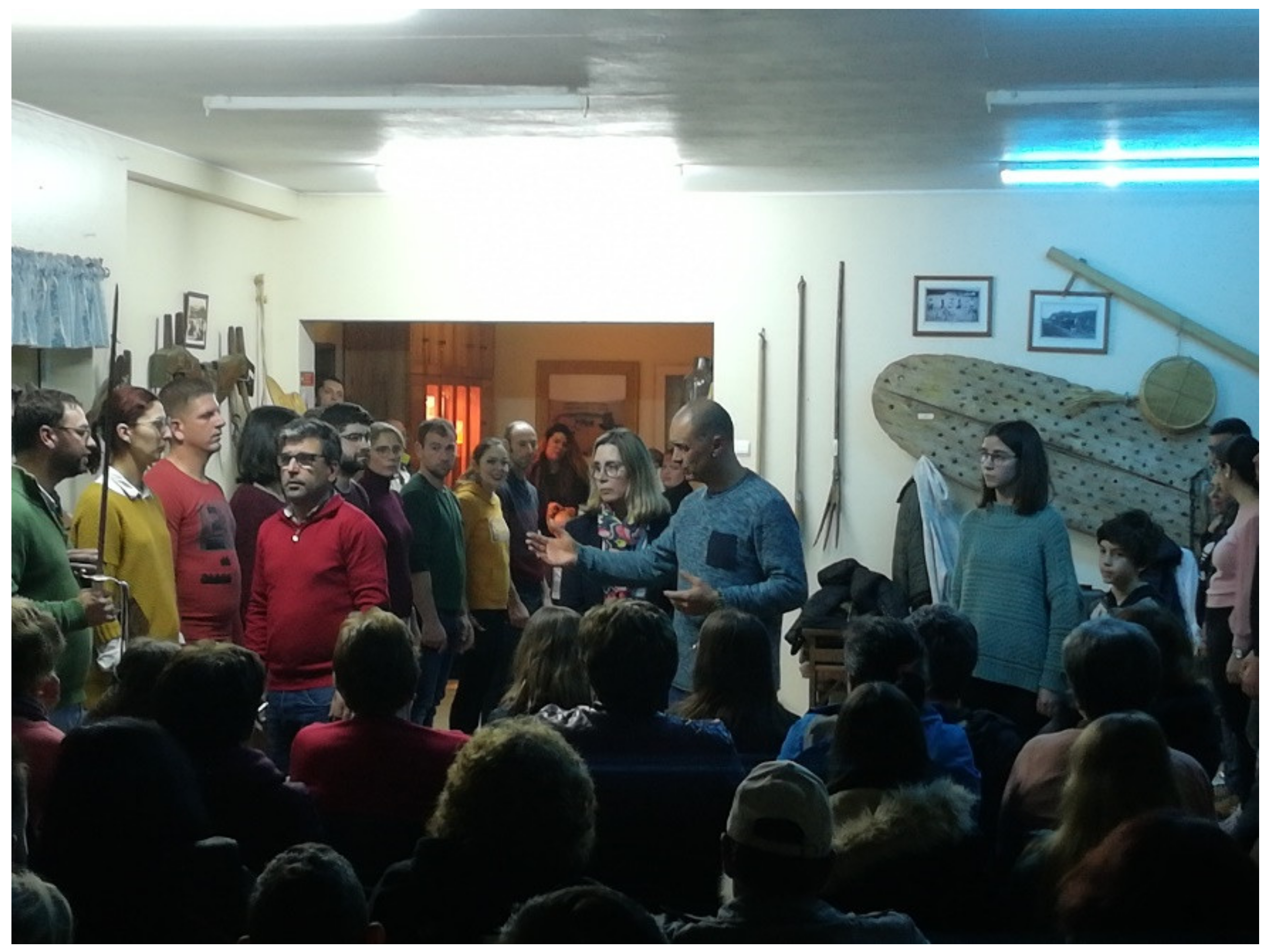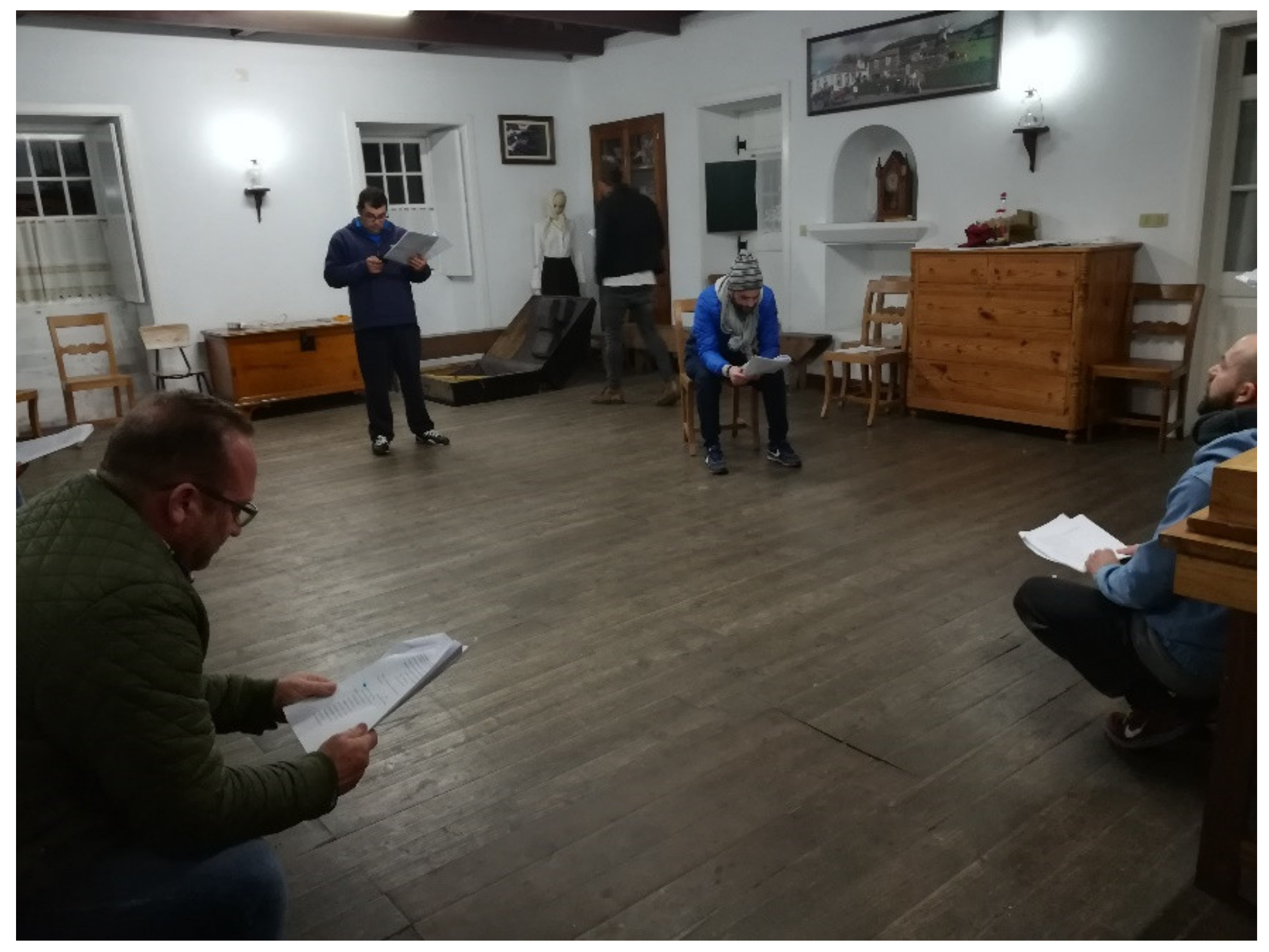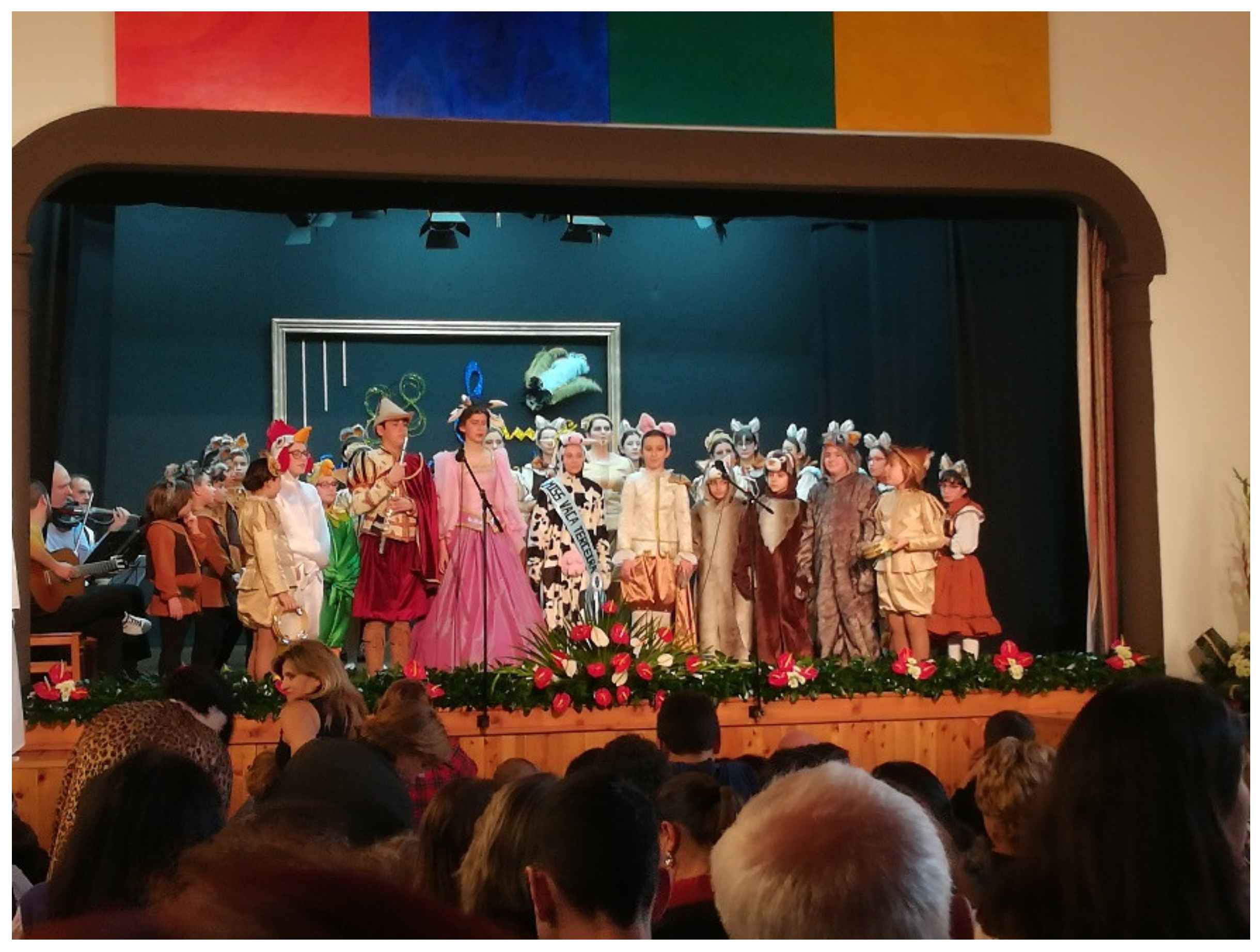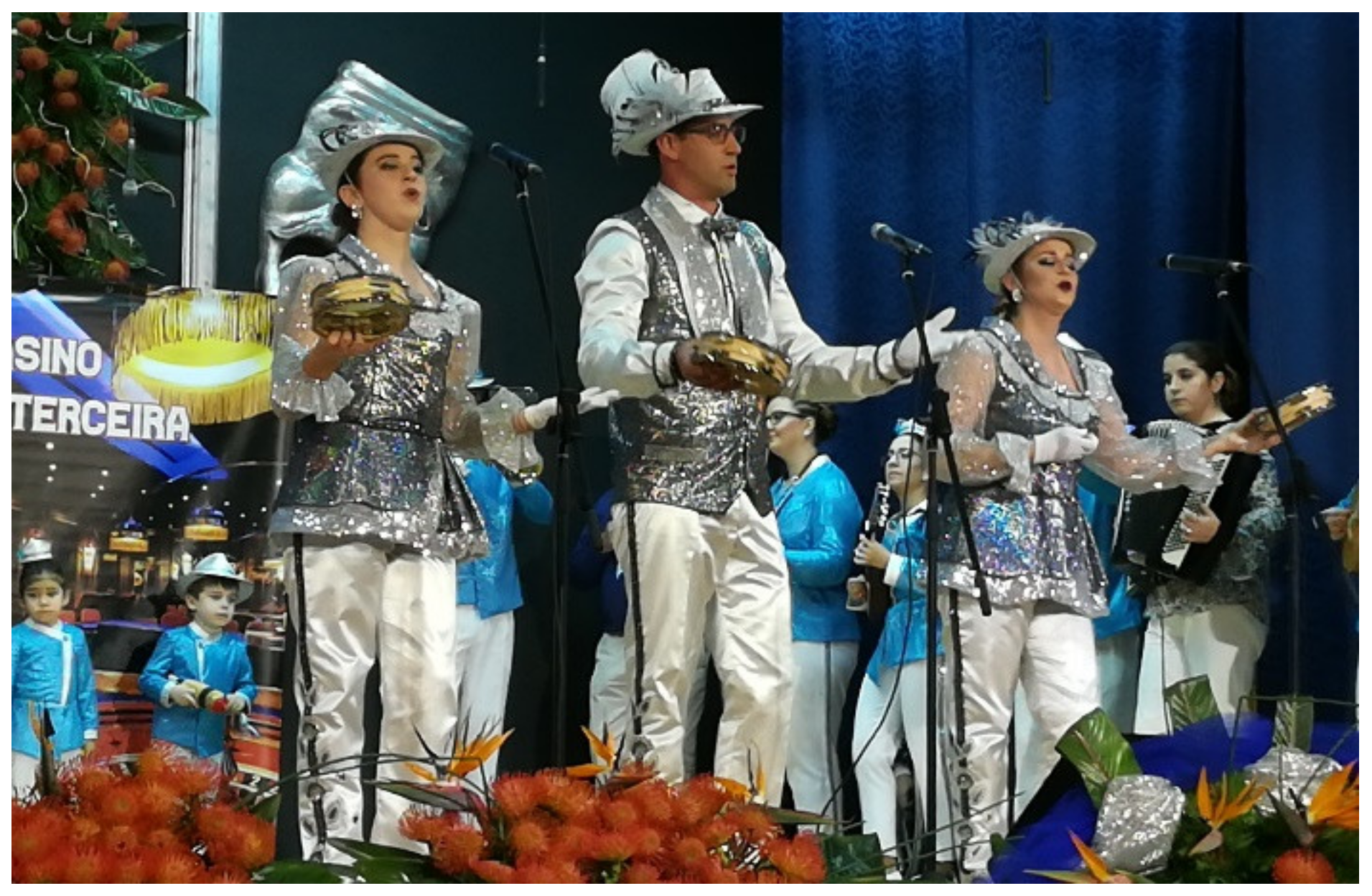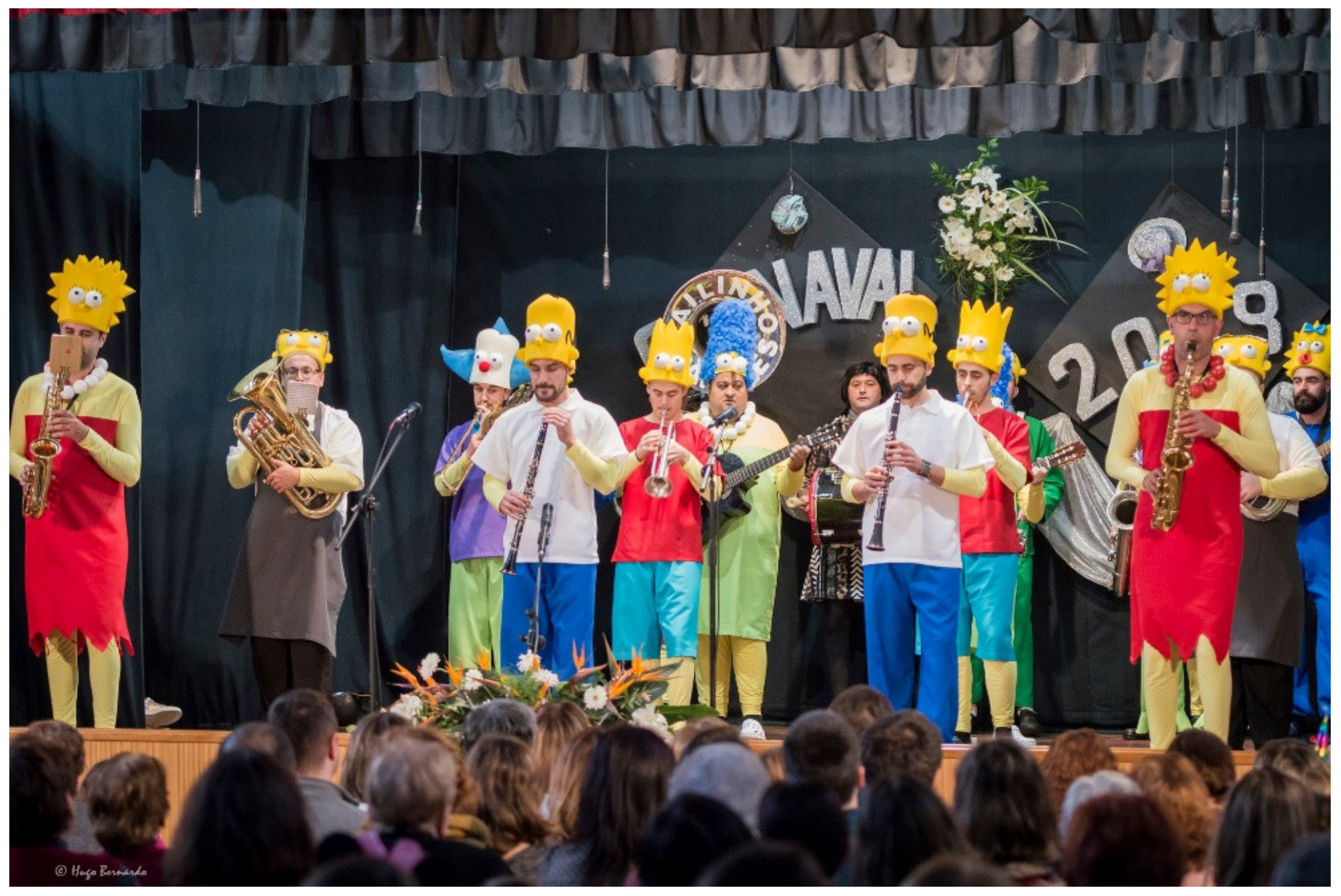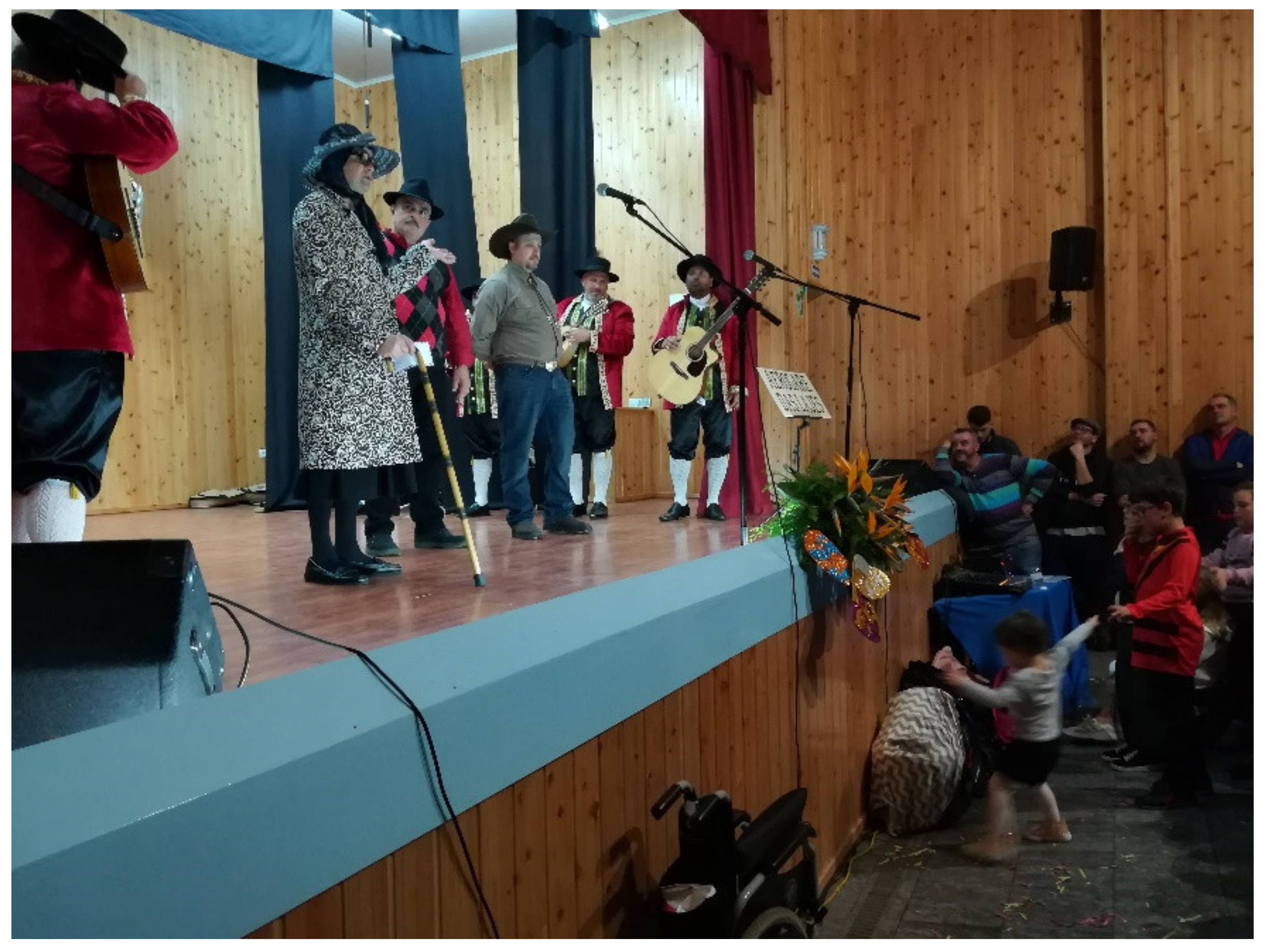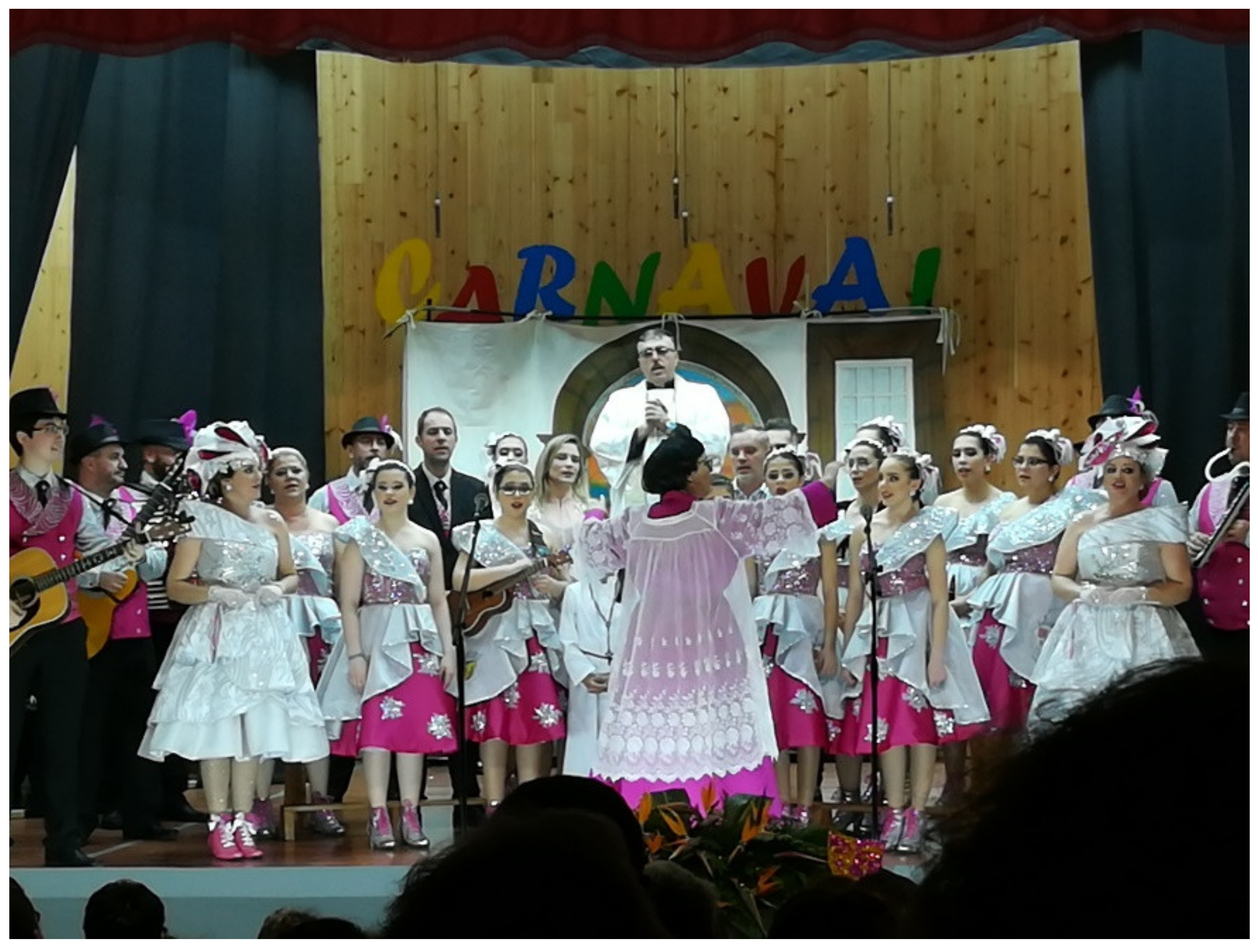1. Introduction
Carnival at large is a seasonal festival, possibly rooted in pagan rituals that were Christianized all across Europe [
1] (p. 224). It is known world-wide mainly because of its most visible expressions, especially those that take place in Rio de Janeiro and Venice. But there are unknown varieties of Carnival that need to be further studied for a number of reasons, including their importance for the affirmation of local identities and for the sustainability of cultural diversity. The Carnival of Terceira Island, which is the second most populated of the Atlantic archipelago of the Azores (Portugal), is a case in point because of the unique way in which it interweaves music, drama, and dance into a satirical mix, with the contribution of a large portion of the community.
Through active participation of the local population in all the stages of the festivities—writing scripts, designing and making clothes, rehearsing, performing—Terceira’s Carnival fosters active citizenship alongside education through art and constitutes a cultural and sustainable force that helps to keep alive the heritage and identity fabric of an island society facing the tensions between globalisation and the preservation of cultural diversity. In fact, the island itself, although it was first settled during the early days of Portuguese expansion, currently enjoys both a distinctive Portuguese identity as well as a status among the other islands of the archipelago by virtue of its cultural heritage and of its geopolitical relevance (e.g., Lajes Air Field), and we argue that it is now touched by transformative processes that are more post-modern in kind than post-colonial, such as the admixture of traditions such as Carnival and the contact between the population and the internationalised media.
This paper presents the preliminary results of an interdisciplinary collaboration between native and foreign scholars (respectively: Azorean and Italian) that focuses on heritage studies and community education. As such, it merges bottom-up and top-down investigative needs. On the one hand, the participation of native scholars in the project could stand as a case of participatory research, which testifies the liveliness of cultural heritage care and preservation among the island community. On the other hand, however, the team expressed concerns that the participation of natives to the initiative—and, in particular, natives belonging to a specific social segment—would result in an attempt to control the narrative on the island’s Carnival.
By taking into account the natives’ needs, the possibility of the above biases, and the challenge of interdisciplinary integration, we drew on the Greater Humanities strategic framework. Originally developed by Clifford [
2] and further developed by Marcelli [
3], the Greater Humanities one is a manifesto that outlines the features of humanist research. Accordingly, it enjoys four dimensions: ethical, empirical, historical, interpretive. That is, all investigations in the humanities shall focus on phenomena that could be empirically appreciated and which enjoy a historical and temporal dimension of their own; furthermore, they should try to understand them (hermeneutics) in ways that solve current (and future) ethical issues. This gives some peace of mind to the cultural scholar since it assumes that no research in the field of humanities is exempt from ethical concerns: as such, it ought to include some level of compromise between participants, as well as the ability to side with them and defend their views.
Ethical concerns could be summarised with the following expression, coined by native scholars: “the unknown carnival”. That would be the Carnival being held on Terceira Island.
Section 3 is dedicated to the understanding of the peripherality of such cultural phenomenon in light of its current exclusion from the UNESCO World Heritage List and in face to local (and regional) efforts to have it included in international inventories.
To achieve such a goal, the first step identified by the team is that of representation and description. Kaufman believes that linking intangible heritage to places through a process of sustainable bureaucratisation might cut the deal [
4]. However, we maintain that we could extend Kaufman’s concept of “space” to non-physical arenas, such as that of media or, as in this case, scholarly production. Therefore, for heritage to be preserved, visibility is necessary in all spaces, either physical or ideal. This brings about two empirical dimensions—one diachronic and one synchronic—the historical one, to which
Section 4 and
Section 5 are dedicated, and the contemporary one, which is addressed in
Section 6 and
Section 7.
Our historical investigation will help establish Carnival as both an identarian practice rooted in Terceira Island and as a creative practice. Other than setting the stage for the later stages of inquiry (
Section 4), the historical sections make a point of identifying Richerson and Boyd’s interpretation [
5] as the most appropriate to understand the evolution of this phenomenon on the island (
Section 5).
Our contemporary investigation illustrates the singularity, taxonomy, and structure of nowadays’ Carnival in Terceira (
Section 6). In the hermeneutic part of the contemporary inquiry (
Section 7), it identifies three core processes that foster the social cohesion of the community: mythopoesis (the birth of Carnival heroes), folk elitism (the distribution of leadership in the community), and subversion of power (when the community feels threatened).
Finally (
Section 8), we present an interpretation of what it means for a community to enjoy cultural sustainability in light of Terceira’s Carnival. In particular, the connection between sustainability and identity is explained with the mediation of the concept of culture. These reflections are then connected to Carnival. Furthermore, Hilbers’ and Turner’s idea that festivals rehearse only the (hi)story of a community [
6,
7] is challenged by using Terceira as a counterexample to their theory.
Given this paper presents the results of an early stage of this interdisciplinary project, it is mostly concerned with setting the stage for future in-depth analyses. This means the greatest length of it is dedicated to an interpretive assessment of both historical data as well as empirical data collected in the rapid appraisal activities undertaken by investigators in 2020. Because the Greater Humanities theoretical framework we adopt does not maintain interpretation and empirical accounts are ontologically separate, we elected not to retain a stark distinction between results and discussion, that is, contrary to what customarily happens with investigations that abide by objectivist theories of knowledge.
4. Terceira’s Carnival: Historical Outlook
Terceira’s Carnival is a unique kind of popular theatre, locally known as
danças de carnaval, or simply
danças [dances], it is deeply rooted in the island’s culture.
Danças are multimodal: they include dancing, music, and acting. Plays range in topics, and participants to
danças classify them as either comic or tragic.
Danças constitute a
sui generis variety of Carnival, which neither falls into “traditional models from Europe, which tend to anthropomorphize bad ghosts through masks and special kinds of clothing” [
12] (p. 87) nor into Rio de Janeiro’s samba parades.
4.1. Mythical Roots
To some extent, danças resemble satires from medieval Europe, including the Portuguese cantigas de escárnio e maldizer (scorn verses), as well as satires written by the Portuguese playwright Gil Vicente (c. 1465–c. 1336). The latter used to portray social and political issues with a satirical, reflective, and critical approach. This ideal connection with Vicente was endorsed, during fieldwork, by a secondary school teacher of Portuguese language and literature, who relocated to Terceira in his late 20s (circa 2014): as such, it constitutes an example of folk theory, through which Terceira’s Carnival participants position themselves in relation to their country’s intellectual history.
The exact origin of Terceira’s Carnival is unknown. Duarte [
12] suggests it originated because Angra do Heroísmo (Terceira’s capital) was the main stopover of the Atlantic sugar trade routes. Hence, the Carnival might have borrowed its practices from Iberia, Madeira, São Tomé e Príncipe, and Brazil in the 15th and in the 16th centuries. According to the same author, in the 19th century some Azoreans who had emigrated to Brazil returned to their homeland and might have imbued Terceira’s culture with the Brazilian Carnival of the time.
However, as Ferreira [
22] pointed out, between 1840 and 1930, Rio de Janeiro Carnival was already experiencing important transformations, marked by an intense negotiation between different values and cultures. Among the recorded contrasts were: the struggle between public order and leisure activities; Portuguese and French influence; conflicts between the bourgeoisie and the working class. Such contradictions resulted in a system of “many Carnivals”. Across the Atlantic, in the same period, similar processes took place in Europe’s urban conglomerates [
23] (pp. 6–13). Terceira, in its active relationship with Brazil and mainland Portugal, as well as with European bourgeoisies, might have been caught in between, with an interplay of sociocultural change and hybridization.
Apparently, in Terceira, Christian institutions played a role in the survival of such phenomena [
12] (p. 97). Frederico Lopes [
24] and José Orlando Noronha Bretão [
11], in their studies on the culture of Terceira Island, state that the first record of
danças can be found in a description of festivities organized by the Society of Jesus in Angra do Heroísmo in 1622 [
25]. On a similar note, by the end of the 18th century, José Joaquim Pinheiro remarks the existence of “dances and pantomimes” in the Monastery of Jesus of Praia, Terceira Island’s second town [
8]. However, such a type of “dança, chacota ou invenção” did not coincide with Carnival [
14] (pp. 35–37).
The establishment of “dances” as typical Carnival performances is attested in 1904, when a crew of seamen organized a Carnival dancing show to collect donations for one of their diseased comrades [
13] (p. 332), [
14] (p. 39). Nonetheless, Duarte [
12] (p. 93) regards 1930 as a more relevant turning point: in that year,
Dança dos Marujos was performed in Corpo Santo, which is a neighbourhood of Angra do Heroísmo, the main town of the island.
4.2. A Rural Phenomenon?
In the 19th century, when Carnival supposedly began to consolidate its presence in Terceira, society became increasingly secular, and Carnival
danças followed through. Concurrently, bourgeois social control over the island’s spaces determined the need for specific licenses in order to perform on the streets [
13] (p. 329). This relegated Carnival to the countryside. Accordingly, the elites of Angra do Heroísmo explicitly dismissed Carnival as an event for “ignorant people” [
13] (p. 326) and, in open opposition to rural practice, promoted parades and balls with different structure and organization [
13] (p. 324). This is in contrast with the Portuguese mainland’s attempts to “civilize Carnival,” such as those of Porto’s bourgeoisie [
26].
In the countryside, Carnival coincided with initiatives organised by individual hamlets, families, or groups of friends, which would tour local homesteads to deliver their performance
en plein air [
27] (p. 90). The hosts would reward them with wine and treats prepared for the occasion [
14] (p. 25). The practice recalled in a song transcribed by Inocêncio Enes (1892–1982), who served for more than six decades as parish priest of Altares: “The lyrics you had to listen to are [now] over; dear landowner, please send for someone to open us the gates” [
28] (pp. 309–310).
This rural practice was still occurring in 1948, when the newspaper
A União reported patrons were hosting
danças in their front yards [
29]. Collected historical pictures record the occurrence of parades in the streets (
Figure 2), where music bands would play, and independent crews would catch the attention of the audience by staging dances on the go, usually exploring current topics in a humorous and frivolous way [
8]. The memories are still fresh among the generation of those born between 1920 and 1940. For instance, during fieldwork a taxi-driver recounted: “[I used to] run behind the
danças that took place in the street, to collect the ribbons that fell from the hats of the dancers, and eventually glue them together with saliva to make a multi-coloured ball” [
30] (p. 151).
4.3. The Twentieth Century and Beyond
Social control became a key issue during the
Estado Novo authoritarian regime, which was active between 1926 and 1974 (but officialised only in 1933): its reactionary policies opposed what did not fit with State propaganda [
31]. As reported by Enes,
danças and
bailinhos were subject to censorship and other restrictions in that period. Instead, the democratic regime that followed
Estado Novo allowed
danças much freedom to express political criticism [
18]. As reported by interviewed performers, after 1974 Terceira’s Carnival gradually shifted from street shows to stages, and the increased availability of transportation (either public or private) allowed acting crews to tour the island and perform in as many stages as possible. “This is all new!” shouted a truck driver to one of the investigators, to overcome the noise of the crowd: “Beforehand, people had no cars, so they would not travel much. So, I tell you: this is all new.”
Figure 3 displays a charter bus of the Empresa de Viação Terceirense (Terceira’s public transport company) that specifically caters for acting crews.
As local communities further developed their taste for music, the number of
Sociedades Filarmónicas (Philharmonic Societies) increased, and theatres began to crop up in all the parishes that could afford their building. By the 1960s, stage shows took the place of road parades [
14] (pp. 43–44). Consequently, organisers began to invest more on set design [
27] (pp. 91). According to an interviewee, the (relatively) cold winter weather played a concurrent role in shifting the stage of Carnival from roads to theatres.
The structure of the most traditional danças de espada (sword dances) and danças de pandeiro (tambourine dances) remained mostly unaltered, whereas bailinhos, whose themes are always light-hearted, extended the segments of acting in each play. This way of organizing carnival was still in place during the 2020 fieldwork activities.
6. Today’s Carnival in Terceira
6.1. Singularity
The postmodern character of many contemporary Carnivals has been discussed by Melotti [
23] (pp. 20–21). According to him, cultural heritage, and therefore Carnival, is a cultural and political product, which can be variously negotiated but is always related to the choices and interests of local communities, main territorial stakeholders, agencies building national narratives, and producers of the “tourist gaze”. Economic interests and identarian dynamics have contributed to re-activate and re-invent feasts and Carnivals, which are increasingly embedded in place-branding activities and in territorial and tourist marketing. Thus, this process testifies to a new role and meaning of contemporary Carnival: it often becomes a space where to stage a global identity based on consumption and leisure models. This happens in Carnivalized postmodern societies, which have extended the once unique (and ritual) experience of Carnival to the whole year.
Terceira’s Carnival enjoys a theatrical nature: it is based on stage performances and deeply rooted community dynamics. Texts are constructed by the community, often related to community internal narratives, and performed by the community (see, e.g.,
Figure 4).
Because its centre is the community, it retains an ‘isolated’ and self-referential character, which, at the same time, reflects the continuity of tradition and the ongoing transformation of the community involved in this tradition. Furthermore, the fact that the texts are written, spoken, and sung in Portuguese contributes to defining a linguistic and cultural boundary in its fruition, limiting its exportability and its inclusion in international and tourism dynamics. On the contrary, Carnivals based on masks, parades, dances, and floats are potentially more suitable to be inserted into over-local and transnational dynamics, and also to be used in tourist and political dynamics (as often happens with UNESCO Carnivals, including the Podence winter feast). We have to add that masked Carnivals, using (or more and more reinventing) traditional masks of animals, monsters, and spirits, are more easily subject to primitivistic approaches that favour both heritagization and tourism fruition in a process often ending in cultural self-crystallization.
In such a perspective, Terceira’s Carnival maintains a peculiar character, expression of its internal tradition, but (up to now) avoids self-crystallization related with heritagization and tourism processes.
Furthermore, this Carnival, being deeply rooted in lively and continuously changing community dynamics, is also a practice capable of absorbing, reflecting, and staging social and cultural change. This is a central point defining a very peculiar status that helps to explain its importance for the community, capable of mirroring itself and the whole society (including not only mainland Portugal but also Western society and, potentially, the rest of the world) through its Carnival stage performances. This is an open door to contemporary global postmodern culture. In other words, Carnival activity lets the community overcome the insular dimension and bridge a gap between the regional and national level as well as between local and global.
6.2. Taxonomy
Nogueira contends that Terceira’s Carnival structure is stable [
30] (pp. 149–150). However, by drawing on Enes’ work [
14] (pp. 39–40) and collected interviews, it is possible to claim the very classification of Carnival-related activities has changed over time. Enes [
13] (p. 328) recounts that, in the 19th century, these shows had no name, or got their name after the costumes worn by dancers: in
dança dos ferreiros, performers would be dressed as blacksmiths; in the
dança da bica, they would be dressed as chickens; in
dança dos pretos, they would wear black faces; in the
dança dos mitrados they would wear the religious garments; and so on [
36].
Later taxonomy divided performances into
danças da noite (night-time dances), performed with tambourines, and
danças de dia (daytime dances), which would become known as
danças de espada. Furthermore, Duarte [
12] (p. 88) mentions the existence of three types of
danças in the 1960s, depending on what is used to direct dancers and actors: either a sword and a whistle (
danças de espada), a tambourine (
danças de pandeiro), or a stick with ribbons (
danças de varinha,
danças de pau de fita or
bailinhos). According to Duarte, sword dances address religious or historical topics, tambourine dances are satirical or tragicomic, and the latter ones are always satirical comedies [
12].
Nowadays, consistent with Enes’ subdivision [
14,
18], all the interviewees, in stark contrast with the analytical subdivisions detailed in the above sections, maintain that there are four types of performances:
danças de espada,
danças de pandeiro,
bailinhos, and
comédias (stand-up comedy or just comic theatre). Occasionally, tambourine dances are included within the broader genre of
bailinhos [
12] (p. 89). However, the
Carnival Guide 2016, published with the patronage of the Azorean Government, distinguishes
danças,
bailinhos, and
comédias and puts tambourine and sword dances in the same category. Such subdivision was later confirmed by a 2020 fieldwork observation in Altares parish and is the one used by the Portuguese list of Intangible Cultural Heritage [
8]. This probably reflects an incoming process of heritagisation and regulation of the feast by agencies and authorities.
The above taxonomies are evidence of the diversity of Terceira’s Carnival. This means its practices are subject to continuing negotiation on behalf of all participants and stakeholders, and strict classification is eluded. This reveals a general feature of “popular culture”, which, according to Slater [
37], has a “dynamic character […] that refuses to respect the fixed, if not always identical, boundaries that scholars draw” [
37] (p. 471).
Although islanders display emotional attachment to the current taxonomy, its fairly recent introduction, which occurred in the second half of the 20th century, is further evidence of the fluid nature of Terceira’s Carnival, almost as if it embodied a local (folk) theory of what it means to party and have fun, rather than constituting a specific type of ritualised festival. Such a view is so entrenched in neighbouring islands that Terceira is famed (and good-naturedly blamed) for being a party hub. As the saying goes: “The Azores is an archipelago that comprises eight islands and one theme park”. Other islands see Terceira as a standalone territory and this is particularly felt in São Miguel, which is the biggest island of the archipelago. As an interviewee put it: “They [Terceirans] are so involved with their Carnival… But I do not feel a connection with it”.
6.3. Pervasiveness
As of 2020, all kinds of
danças are organized by groups of amateur actors, usually between 50 and 60 groups per year, who follow an itinerary of performances in more than thirty stages around the island, during a period of four or more days, just before
Ash Wednesday. In fact, there are 35 permanent stages, which usually belong to local associations. In two specific cases, the stages belong to the Municipal Theatres of the island’s main towns: Angra do Heroísmo and Praia da Vitória. These are the only two cases in which access to the performances is paid.
Danças and
bailinhos may also have some specific performances outside the main itinerary, for example, at schools and nursing homes. Some performances are organized by schools themselves, which reinforces the educational strand of Terceira’s Carnival (
Figure 5). Groups that comprise students, teachers, and other staff members rehearse and perform within their own elementary or secondary schools, and then integrate themselves into the main itinerary.
According to the Portuguese National Inventory of Intangible Cultural Heritage, Terceira’s Carnival involves about “1250 people”, counting “only those who perform on stage”, which perform in about 1000 shows all across the island [
8]. The figure of 2200 min of performance, recorded in the Inventory, is more tentative: it assumes a single acting company performs in all stages of the island. This is not always the case.
6.4. Structure
The basic structure is similar in all
danças. A
dança consists of a play that is written in verses; it includes live music and dances, as well as simple dancing choreographies at the beginning, in the middle, and at the end of the performance. The actors and the dancers are led by a “master” who wears showy clothes and sings in order to greet the audience, identify the parish where the
dança comes from, introduces the topic and the plot of the play, and also presents a conclusion with an emphasis on “the moral of the story” [
12] (p. 88), just before saying goodbye at the end. Dancers tend to be organized into two wings. In
danças de espada, actors and dancers constitute two separated groups, whereas in
danças de pandeiro and
bailinhos the same performers can act, dance, and play musical instruments. The main difference between a
dança de pandeiro (
Figure 6) and a
bailinho (
Figure 7) is the fact that the “master” plays a tambourine in the former and uses a stick with ribbons in the latter.
However, many
danças and
bailinhos have increasingly introduced changes to the traditional structure. For example, nowadays some of them have several “masters” instead of one, others have no “master” at all, sometimes a short theatrical scene precedes the first words of the “master”, and so on. Far from being relics of historical tradition,
danças stage the complexity of a contemporary global consumption society, which is the element unifying island and mainland cultures, as well as Portuguese and global cultures. Texts and choreographies, for instance, exploit television, movies, cartoons, and advertisements to build original narratives related to topics and issues significant for the community. That is the case of Bailinho dos Rapazes das Doze Ribeiras, which, during the 2019 Carnival, performed
Os Simpsons (
Figure 7), featuring the characters of one the most popular American series to make, as they explained, “social satire” [
36].
8. Terceira’s Carnival and the Hermeneutics of Sustainability, Culture, and Identity
8.1. Cultural Sustainability
Sustainability has occupied the centre of the debate leading to awareness of the challenges facing humankind in the 21st century. Primarily concerned with economic, social, or environmental issues, sustainability has widened its scope in order to reach other fields, namely the cultural arena. After UNESCO had declared 1988–1997 as the World Decade for Cultural Development, the concept of culture gained a renewed dynamism. Reports have increasingly highlighted unequivocal bonds between cultural processes and development on different levels: prosperity, diversity, security, and preservation. The ground was prepared for Jon Hawkes to signal culture as the fourth pillar of sustainability, in 2001. From that point on, several authors and institutions have offered different perspectives on the nexus involving culture and economic development, the preservation of natural resources, environmental balance, the fight against poverty, social inequalities, and/or exclusion from the centres of authority and power.
One of these perspectives states that cultural sustainability is linked to the autonomous development of identities able to resist uniformity-based models of thinking and acting [
41]. Another perspective emphasizes the importance of the cultural sector for awareness-raising measures of environmental protection and respect for tangible and intangible cultural heritage [
42]. A third perspective focuses on the financial viability of cultural actions and projects [
43].
8.2. Culture and Identity
Our preliminary study touches on the first one of these perspectives, and it emerges that culture and identity overlap. They share a common field where questions about who we are, both in personal and collective terms, are raised, and methods of preserving cultural heritage are endorsed. As Hawkes points out, culture participates actively in strengthening values and priorities laying at the core of identity: democracy, inclusion, creativity, imagination, freedom, justice, peace, health, well-being, and vitality are some of the elements that help define who we are and the society we live in, therefore constituting the broad scenario where these concepts meet [
44] (p. 7).
At this point, it might prove useful to clarify the sense in which each of the terms is used. By culture, we mean the sphere in which meaning is produced and disseminated [
45] (p. 51), the arena where conflict, protest, and resistance [
46] (pp. 56–61) coexist with conformity and acceptance of representations concerning the self and the fixation of social roles.
It comes as no surprise that, within this expanded territory, identity should occupy an important place. Recent theories of identity formation, namely those originated in media studies, expose the difficult task of studying identity as an isolated concept, estranged from culture, education, or politics. As underlined by Hartley [
45] (p. 100), when analysing identity, these theories “often refer to representations and their cultural consequences”, that is, they build their analysis upon the same sources that Cultural Studies use as working material. Identity politics, for example, “aims to provide a form of political participation for those who are excluded from the traditional means of representation” [
45] (p. 101), a goal shared by Cultural Studies as well.
Despite this common ground, there is no risk of confusing identity with culture. Identity privileges the awakening of self-awareness and of self-assertion alongside the formation of shared spaces of belonging and the struggle to validate them
even if they are different, if not
because they are different. Identity is therefore relational and oppositional. Freitas Jr. and Perucelli [
47] (p. 112) seem to agree with this perspective, as they declare that identity is both “a person’s predilections” and “the specific place of belonging which is shaped by culture, including the symbolic grid, beliefs and values that made history”.
The narrative and storytelling of Carnival are, thus, major factors in coming to terms with a community’s roots without falling into the mistaken idea that they define us forever. Part of who we are, or are becoming, is imaginary and symbolic, and therefore constructed inside discursive strategies. Identity is formed within “figured worlds” [
48], spaces where people “figure” who they are “through the activities and in relation to the social types that populate these worlds” [
49] (p. 19). Work locations, schools, and leisure spaces are important sites to “figure” and therefore to trigger action bringing self-awareness and transformation.
But attachment and identification are temporary. Identity is sutured by “points of temporary attachment to the subject positions which the discursive practices construct for us” [
50] (p. 6). All identities are consequently plural and dynamic, “multiply constructed, across different, often intersecting, antagonistic discourses, practices, and positions”, subject to a “radical historicization” and to an endless “process of change” [
50] (p. 4).
8.3. Identity and Power
A point of fact is that “identity is about power. Power is at the root of who ‘counts’ as belonging to an identity, as well as who is able to self-define, self-identify, and deny to others their identity” [
49] (p. 4). As stressed by Stuart Hall, identity can only function as attachment if it uses the power “to exclude, to leave out, to render ‘outside’” [
50] (p. 5). It is crucial to understand the mechanisms that produce and distribute power, be it material, social, or symbolic, in order to identify patterns of dominance/dependence, oppression/agency, and to revise what is validated or rebuked, who is heard and who is ignored, so that all identities receive equal treatment and benefit from the same rights and opportunities.
Human activities are repeatedly constrained by parts of the environment and, in turn, effect changes on it. Hence, whenever an act of power takes place, even spontaneously, the fabric of society is folded, perchance ruptured, meaning all making of Self comes at a cost (be it environmental, political, or both). As Heizmann and Liu put it: “sustainability issues are intrinsically tied to issues of identity” [
51] (p. 4, see also [
27]).
In the last years of the 20th century, contributions from Anthropology [
48], Feminism [
52], Cultural Studies [
50], and Literature [
53] offered a new perspective, following the very influential paper of Davies and Harré [
54]. The basic assumption is that the individual’s positioning in terms of race, gender, and class often surfaces in speech acts and symbolic representations. Discursive practices and representations are, thus, an important tool not only for forming individual identity, but for empowerment, resistance, will, and agency. Cultural processes dealing with critical and creative possibilities in several representation systems, especially language, foster imagination, improvisation, and innovation, moving away from (even if incompletely) determinism and dependence.
The ability to entertain multiple dialogues is a means of endowing oneself with a voice that is actually heard externally, a voice that enjoys the satisfaction of authorship, and, at the same time, responds to a world in which struggles for power are constant. Identity formed in the context of activity and language can strengthen collective bonds, promote membership, and effect changes, while simultaneously generating a sense of personal accomplishment. In the same line of thought, Moran [
55] defends that identities are shaped within the joint forces of the self and the others. The claim for association is always present, requiring individuals that are driven and willing to adjust to unstable environments. The performative aspect of identity has been highlighted by Judith Butler [
52] in her studies of feminist identity, but is equally applicable to other identities. Performance enables individuals to experience ways of acting in life, which expands their range of choice with regard to who they want to be and to become. Through cultural performance, the individual is put at the centre not only of cultural activity but of socio-political action, which, in turn, raises issues of citizenship. From this perspective, a citizen is a dynamic unity of the individual self and the communitarian self [
56,
57] that is, a human being who interacts with the Other in a given space and faces challenges. The challenge of ensuring sustainability for future generations is a case in point.
8.4. Tackling Azorean Identity
As we turn to studies concerning Azorean identity, we notice the prevalent use of an essay by the Azorean writer Vitorino Nemésio [
58], entitled “
Açorianidade” (Azoreaness), which offers a definitive statement on being an islander and living in the Azores. The author highlights the importance of the clouded sky, humidity, the smallness of the islands, volcanism, religion, and the ever-present ocean.
Important as this text is, it does not account for conflict in Azorean society; on the contrary, it presents a static image of an ordered society threatened mainly by external factors, namely industrialisation and foreign practices. Social inequality, power struggles, resistance to dominance, internal change, and fracture are neglected within the general idealisation of a rural landscape which is perfect except for the natural catastrophes it is subject to, owing to its volcanic origin. But even this challenging element aids to compose an idealised description of the population.
Thus, it is epistemically more appropriate to shift attention from top-down approaches to identity, which use ready-made categories, to bottom-up processes of identity-making. Accordingly, we argue that the case of Carnival as it appears on Terceira Island can be understood on the basis of a non-essentialist view of identity, that is, one that emphasises the interplay between identity, power, and sustainability that we have summarised above.
Carnival is a popular festival, which could be classified as a “folk practice”. As such, it requires popular commitment to a common performative goal, which is not directly linked to issues of environmental fitness for the practicing population. Nonetheless, Terceira’s Carnival tells a tale of sustainability: on the one hand, it puts a stress on the island’s resources (either human or material); on the other hand, it offers an inclusive model of interaction, which is a key element of societal cohesion, wellbeing, and welfare. Moreover, this Carnival represents a case of community education that stands at the crossroads between formal practices and informal learning.
It is a regulated activity through which creativity is expressed, thus triggering individual innovations within the frame of seemingly fixed theatrical practices. It represents popular authorship and offers a critical view of social institutions, figures of authority, and centres of power.
Postmodern practices and sustainability entertain a complex relationship, and Terceira’s Carnival is no exception. In this study, we have identified a diversified web of connections between Terceira’s Carnival and social classes, cultural practices, folk art, intangible cultural heritage, identity, and sustainability. There is clear evidence of it mirroring and contributing to the design of a specific island identity within the Azorean context.
8.5. A Counterexample to Hilbers’ and Turner’s Theory
Terceira’s Carnival challenges the entrenched views on the identity-making function of “community festivals”. In this respect, it does not meet requirements for the definition proposed by Hilbers [
6] (p. 24). Hilbers draws on Turner [
7] and claims “community festivals and celebrations are ritual events that tell the story of a people, often through music, dance, art, food, and iconography.” Moreover, he contends they blend storytelling and story-making, by making these practices become part and parcel of a community’s identity-making practices. Yet, in the view of Turner, Carnivals do not belong to such category: he sets them aside because he believes they enjoy a non-compulsory nature and, as such, they cannot enjoy the status of “rituals”.
The case of Terceira proves otherwise. It enjoys both a ritual nature and a creative opening towards the re-definition of the community identity. Its flexibility is at the core of its sustainability, because Terceira’s Carnival enables participants to shift positions across the social spectrum and, alternatively, to either support the status quo or hurl the community towards the unknown. As De Matteis put it, festivals cannot be only about the (hi)story of a given community [
59] (p. 20), and Terceira proves the point.
Does lack of historicity entail challenges in identity-making? Quite the opposite: Terceira’s Carnival enjoys a strong identity, not because of its specific contents, but because it is a process. Contents, such as the topics of Carnival tales, are fully negotiable; the structure is negotiable too, as demonstrated by our historical appraisal. This leaves identity-making to the enactment of a process.
If, for Turner [
7] (pp. 86–87), “tribal” communities are so norm-driven that even the festivals’ subversion of social order is dictated by collective rules, “modern” communities, to the contrary, deploy practices that emphasise the inventiveness of emancipated individuals. Terceira’s Carnival is an exacerbation of the latter. By pushing such reasoning even further, it could be possible to frame Terceira’s Carnival as a practice that, through its emergent character, steers a society towards a postmodern fruition of cultural (co-constructed) reality, although maybe not in the ‘continental’ ways understood by Melotti [
23].
Its theatrical element enhances creativity and adds cultural value to both individuals and the community. Its performances interweave music, drama, and dance into a satirical mix, which highlights the multi-faceted nature of collective prosocial undertakings that reflect the yearly social, economic, and political agenda. The point of view is not determined by authorities, the elites, or those who hold power, but by a combination of players from several social backgrounds. Rural minorities take the floor, and the subversion of power roles offers them visibility.
One of the most salient findings of this study is that Terceira’s Carnival fosters active citizenship, as it brings together people who otherwise would hardly meet around the leading concerns of the community every year; it promotes education through art, by creating an opportunity to practice storytelling, dancing, playing music, singing, and acting; it constitutes a cultural force, which, by means of sustainable conduct, manages to keep tradition alive without neglecting contemporary matters of general interest. To put it simply, it helps to preserve the fabric of an island society that faces the tensions between globalisation and cultural diversity. In the process, it empowers the participants, whose voice is heard and even written for future memory.
9. Conclusions
In this paper, we endeavoured to illustrate several points concerning Terceira’s Carnival. First, it constitutes a projection towards an idealised communal history, rather than the result of long-term historical processes. Second, the best way to understand its double nature or rural and urban Carnival is better explained by the theory of dual cultural evolution. Third, the analysis of its taxonomy shows that both its structure and understanding has changed over the past hundred years. Fourth, it features three concurrent processes that contribute to community cohesion: mythopoesis (local ‘heroes’), folk elitism (distribution of power), and subversion (reaction to hegemony).
Consequently, we argued that Terceira’s Carnival displays both modern and postmodern features and is employed by the islanders as a tool to negotiate their identities in face of ensuing globalisation. They are able to do so thanks to the identarian dimension of the process, which, in turn, makes it possible to create a self-referential sandbox in which islanders can stage their values. This makes Terceira’s Carnival a case of cultural sustainability: the practice, as it was observed in 2020, is healthy and far from being crystallised by administrative heritagisation processes. Notwithstanding its relative wealth, this phenomenon remains marginalised owing to the peripheral nature of Azores islands and calls for greater attention towards its possible inclusion in international inventories.
